Taming the Data Beast: Your Guide to the Normalization Process, Mapping & Validation

Learn how data validation, data mapping, and normalization work together to clean and organize your CSV files. Includes real-world flat file examples.
Let’s get into the nitty-gritty of how data validation and data mapping play into the world of data normalization. Ready to tame that data beast?
What Is Data Validation?
Data validation is how you make sure your data is correct and usable. It checks if:
-
Dates are actually dates
-
Numbers are within valid ranges
-
Emails are emails (not gibberish)
Think of it as spell-check for your spreadsheets. We plan on incoorporating the same within CSV Normalize, to make data normalization even easier!
Connecting the Dots: Data Mapping
What is mapping of data, you ask? Or what is a data map? It’s the process of matching fields from your source data (like your clean CSV file) to the corresponding fields in the destination system. Think of it like creating instructions: “This ‘Customer Name’ column in my CSV goes into the ‘ContactName’ field in the database.” You might use a visual tool or even a simple mapping file to define these connections. Effective database mapping relies heavily on having clean, predictable, normalized source data. Trying to create data maps from messy, inconsistent data is a recipe for frustration and errors.
Bringing it All Together with Flat File Examples
Imagine you have a sample flat file containing customer orders exported from an old system. It might list the customer’s full address in every single row, have inconsistent product names, and maybe even some invalid email addresses.
-
Validation: First, you’d run data validation checks to fix those emails and flag questionable entries.
-
Normalization: Then, you’d apply the normalization data process. This might involve standardizing product names and perhaps (if moving to a real database) separating customer addresses into a different related table. Even in a CSV, you ensure consistency.
-
Mapping: Finally, with your clean data, you can easily perform data mapping to import those orders into your new sales system.
CSVNormalize: Your Data Mapping + Validation Sidekick
CSVNormalize can help:
-
Apply data maps to standardize field names
-
Run data validation on the fly
-
Output clean, normalized data ready for use
Clean data is happy data. When your files go from chaos to order, you:
-
Save time
-
Reduce errors
-
Make your systems more efficient
Whether you’re a developer, analyst, or just someone tired of fixing Excel errors, CSVNormalize is here to help.